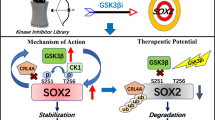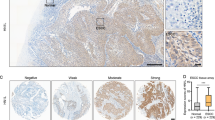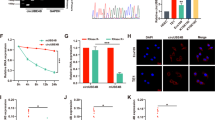Abstract
The presynaptic cytomatrix protein Piccolo, encoded by PCLO, is frequently mutated and amplified in esophageal squamous cell carcinoma (ESCC), but its exact roles in ESCC remain unclear. Here we report that Piccolo expression correlates significantly with clinical stage, patient survival and tumor embolus. Functional studies demonstrate that PCLO knockdown remarkably attenuates ESCC malignancy in vitro and in vivo, and ectopic EGFR expression partially compensates for Piccolo loss. PCLO knockdown promotes ubiquitination and degradation of EGFR, which is associated with the negative regulatory effect of Piccolo on E3 ligase Siah1. An anti-Piccolo monoclonal antibody inhibited tumor proliferation in a mouse model of ESCC. These results demonstrate that Piccolo contributes to tumor aggressiveness in ESCC, likely by stabilizing EGFR and promoting EGFR-dependent signaling. Our results further suggest that Piccolo may represent a novel prognostic biomarker and therapeutic target for patients with ESCC.
This is a preview of subscription content, access via your institution
Access options
Subscribe to this journal
Receive 50 print issues and online access
$259.00 per year
only $5.18 per issue
Buy this article
- Purchase on Springer Link
- Instant access to full article PDF
Prices may be subject to local taxes which are calculated during checkout








Similar content being viewed by others

References
Song Y, Li L, Ou Y, Gao Z, Li E, Li X et al. Identification of genomic alterations in oesophageal squamous cell cancer. Nature 2014; 509: 91–95.
Lin DC, Hao JJ, Nagata Y, Xu L, Shang L, Meng X et al. Genomic and molecular characterization of esophageal squamous cell carcinoma. Nat Genet 2014; 46: 467–473.
Zhang Y, Qiu Z, Wei L, Tang R, Lian B, Zhao Y et al. Integrated analysis of mutation data from various sources identifies key genes and signaling pathways in hepatocellular carcinoma. PLoS One 2014; 9: e100854.
Fujimoto A, Furuta M, Shiraishi Y, Gotoh K, Kawakami Y, Arihiro K et al. Whole-genome mutational landscape of liver cancers displaying biliary phenotype reveals hepatitis impact and molecular diversity. Nat Commun 2015; 6: 6120.
Lohr JG, Stojanov P, Lawrence MS, Auclair D, Chapuy B, Sougnez C et al. Discovery and prioritization of somatic mutations in diffuse large B-cell lymphoma (DLBCL) by whole-exome sequencing. Proc Natl Acad Sci USA 2012; 109: 3879–3884.
Zhai RG, Vardinon-Friedman H, Cases-Langhoff C, Becker B, Gundelfinger ED, Ziv NE et al. Assembling the presynaptic active zone: a characterization of an active one precursor vesicle. Neuron 2001; 29: 131–143.
Fenster SD, Kessels MM, Qualmann B, Chung WJ, Nash J, Gundelfinger ED et al. Interactions between Piccolo and the actin/dynamin-binding protein Abp1 link vesicle endocytosis to presynaptic active zones. J Biol Chem 2003; 278: 20268–20277.
Limbach C, Laue MM, Wang X, Hu B, Thiede N, Hultqvist G et al. Molecular in situ topology of Aczonin/Piccolo and associated proteins at the mammalian neurotransmitter release site. Proc Natl Acad Sci USA 2011; 108: E392–E401.
Takao-Rikitsu E, Mochida S, Inoue E, Deguchi-Tawarada M, Inoue M, Ohtsuka T et al. Physical and functional interaction of the active zone proteins, CAST, RIM1, and Bassoon, in neurotransmitter release. J Cell Biol 2004; 164: 301–311.
Fenster SD, Chung WJ, Zhai R, Cases-Langhoff C, Voss B, Garner AM et al. Piccolo, a presynaptic zinc finger protein structurally related to bassoon. Neuron 2000; 25: 203–214.
Wang X, Kibschull M, Laue MM, Lichte B, Petrasch-Parwez E, Kilimann MW . Aczonin, a 550-kD putative scaffolding protein of presynaptic active zones, shares homology regions with Rim and Bassoon and binds profilin. J Cell Biol 1999; 147: 151–162.
Garner CC, Nash J, Huganir RL . PDZ domains in synapse assembly and signalling. Trends Cell Biol 2000; 10: 274–280.
Garcia J, Gerber SH, Sugita S, Sudhof TC, Rizo J . A conformational switch in the Piccolo C2A domain regulated by alternative splicing. Nat Struct Mol Biol 2004; 11: 45–53.
Gerber SH, Garcia J, Rizo J, Sudhof TC . An unusual C(2)-domain in the active-zone protein piccolo: implications for Ca(2+) regulation of neurotransmitter release. EMBO J 2001; 20: 1605–1619.
Cremona O, De Camilli P . Phosphoinositides in membrane traffic at the synapse. J Cell Sci 2001; 114: 1041–1052.
Andl CD, Mizushima T, Nakagawa H, Oyama K, Harada H, Chruma K et al. Epidermal growth factor receptor mediates increased cell proliferation, migration, and aggregation in esophageal keratinocytes in vitro and in vivo. J Biol Chem 2003; 278: 1824–1830.
Abedi-Ardekani B, Dar NA, Mir MM, Zargar SA, Lone MM, Martel-Planche G et al. Epidermal growth factor receptor (EGFR) mutations and expression in squamous cell carcinoma of the esophagus in central Asia. BMC Cancer 2012; 12: 602.
Cao HH, Zheng CP, Wang SH, Wu JY, Shen JH, Xu XE et al. A molecular prognostic model predicts esophageal squamous cell carcinoma prognosis. PLoS One 2014; 9: e106007.
Hanawa M, Suzuki S, Dobashi Y, Yamane T, Kono K, Enomoto N et al. EGFR protein overexpression and gene amplification in squamous cell carcinomas of the esophagus. Int J Cancer 2006; 118: 1173–1180.
Kalabis J, Wong GS, Vega ME, Natsuizaka M, Robertson ES, Herlyn M et al. Isolation and characterization of mouse and human esophageal epithelial cells in 3D organotypic culture. Nat Protoc 2012; 7: 235–246.
Lehman HL, Yang X, Welsh PA, Stairs DB . p120-catenin down-regulation and epidermal growth factor receptor overexpression results in a transformed epithelium that mimics esophageal squamous cell carcinoma. Am J Pathol 2015; 185: 240–251.
Navarini D, Gurski RR, Madalosso CA, Aita L, Meurer L, Fornari F . Epidermal growth factor receptor expression in esophageal adenocarcinoma: relationship with tumor stage and survival after esophagectomy. Gastroenterol Res Pract 2012; 2012: 941954.
Shang L, Liu HJ, Hao JJ, Jiang YY, Shi F, Zhang Y et al. A panel of overexpressed proteins for prognosis in esophageal squamous cell carcinoma. PLoS One 2014; 9: e111045.
Yang YL, Xu KL, Zhou Y, Gao X, Chen LR . Correlation of epidermal growth factor receptor overexpression with increased epidermal growth factor receptor gene copy number in esophageal squamous cell carcinomas. Chin Med J 2012; 125: 450–454.
Gao Z, Meng X, Mu D, Sun X, Yu J . Prognostic significance of epidermal growth factor receptor in locally advanced esophageal squamous cell carcinoma for patients receiving chemoradiotherapy. Oncol Lett 2014; 7: 1118–1122.
Wang Q, Zhu H, Xiao Z, Zhang W, Liu X, Zhang X et al. Expression of epidermal growth factor receptor is an independent prognostic factor for esophageal squamous cell carcinoma. World J Surg Oncol 2013; 11: 278.
Sunpaweravong P, Sunpaweravong S, Puttawibul P, Mitarnun W, Zeng C, Baron AE et al. Epidermal growth factor receptor and cyclin D1 are independently amplified and overexpressed in esophageal squamous cell carcinoma. J Cancer Res Clin Oncol 2005; 131: 111–119.
Adzhubei IA, Schmidt S, Peshkin L, Ramensky VE, Gerasimova A, Bork P et al. A method and server for predicting damaging missense mutations. Nat Methods 2010; 7: 248–249.
Ng PC, Henikoff S . SIFT: Predicting amino acid changes that affect protein function. Nucleic Acids Res 2003; 31: 3812–3814.
Cerami E, Gao J, Dogrusoz U, Gross BE, Sumer SO, Aksoy BA et al. The cBio cancer genomics portal: an open platform for exploring multidimensional cancer genomics data. Cancer Discov 2012; 2: 401–404.
Gao J, Aksoy BA, Dogrusoz U, Dresdner G, Gross B, Sumer SO et al. Integrative analysis of complex cancer genomics and clinical profiles using the cBioPortal. Sci Signal 2013; 6: pl1.
Sorkin A, Waters CM . Endocytosis of growth factor receptors. Bioessays 1993; 15: 375–382.
Xue L, Ren L, Zou S, Shan L, Liu X, Xie Y et al. Parameters predicting lymph node metastasis in patients with superficial esophageal squamous cell carcinoma. Mod Pathol 2012; 25: 1364–1377.
Waites CL, Leal-Ortiz SA, Okerlund N, Dalke H, Fejtova A, Altrock WD et al. Bassoon and Piccolo maintain synapse integrity by regulating protein ubiquitination and degradation. EMBO J 2013; 32: 954–969.
Sander JD, Joung JK . CRISPR-Cas systems for editing, regulating and targeting genomes. Nat Biotechnol 2014; 32: 347–355.
Arteaga CL, Engelman JA . ERBB receptors: from oncogene discovery to basic science to mechanism-based cancer therapeutics. Cancer Cell 2014; 25: 282–303.
Zhang H, Jin Y, Chen X, Jin C, Law S, Tsao SW et al. Cytogenetic aberrations in immortalization of esophageal epithelial cells. Cancer Genet Cytogenet 2006; 165: 25–35.
Shen ZY, Xu LY, Li EM, Cai WJ, Chen MH, Shen J et al. Telomere and telomerase in the initial stage of immortalization of esophageal epithelial cell. World J Gastroenterol 2002; 8: 357–362.
Yang F, Zhang W, Li D, Zhan Q . Gadd45a suppresses tumor angiogenesis via inhibition of the mTOR/STAT3 protein pathway. J Biol Chem 2013; 288: 6552–6560.
Acknowledgements
We appreciated Jie Chen and Tian Lan for revising this manuscript and offering constructive advices. This work is supported by the National 973 Program (2015CB553904) and National Natural Fund of China (81230047 and 81321091).
Author information
Authors and Affiliations
Corresponding author
Ethics declarations
Competing interests
The authors declare no conflict of interest.
Additional information
Supplementary Information accompanies this paper on the Oncogene website
Supplementary information
Rights and permissions
About this article
Cite this article
Zhang, W., Hong, R., Xue, L. et al. Piccolo mediates EGFR signaling and acts as a prognostic biomarker in esophageal squamous cell carcinoma. Oncogene 36, 3890–3902 (2017). https://doi.org/10.1038/onc.2017.15
Received:
Revised:
Accepted:
Published:
Issue Date:
DOI: https://doi.org/10.1038/onc.2017.15
This article is cited by
-
Inflammatory brain lesions preceding primary central nervous system lymphoma: a case report and genetic analysis
Neurological Sciences (2023)
-
EphA5 knockdown enhances the invasion and migration ability of esophageal squamous cell carcinoma via epithelial-mesenchymal transition through activating Wnt/β-catenin pathway
Cancer Cell International (2020)
-
Patient-specific cancer genes contribute to recurrently perturbed pathways and establish therapeutic vulnerabilities in esophageal adenocarcinoma
Nature Communications (2019)
-
The chromosome 11q13.3 amplification associated lymph node metastasis is driven by miR-548k through modulating tumor microenvironment
Molecular Cancer (2018)


